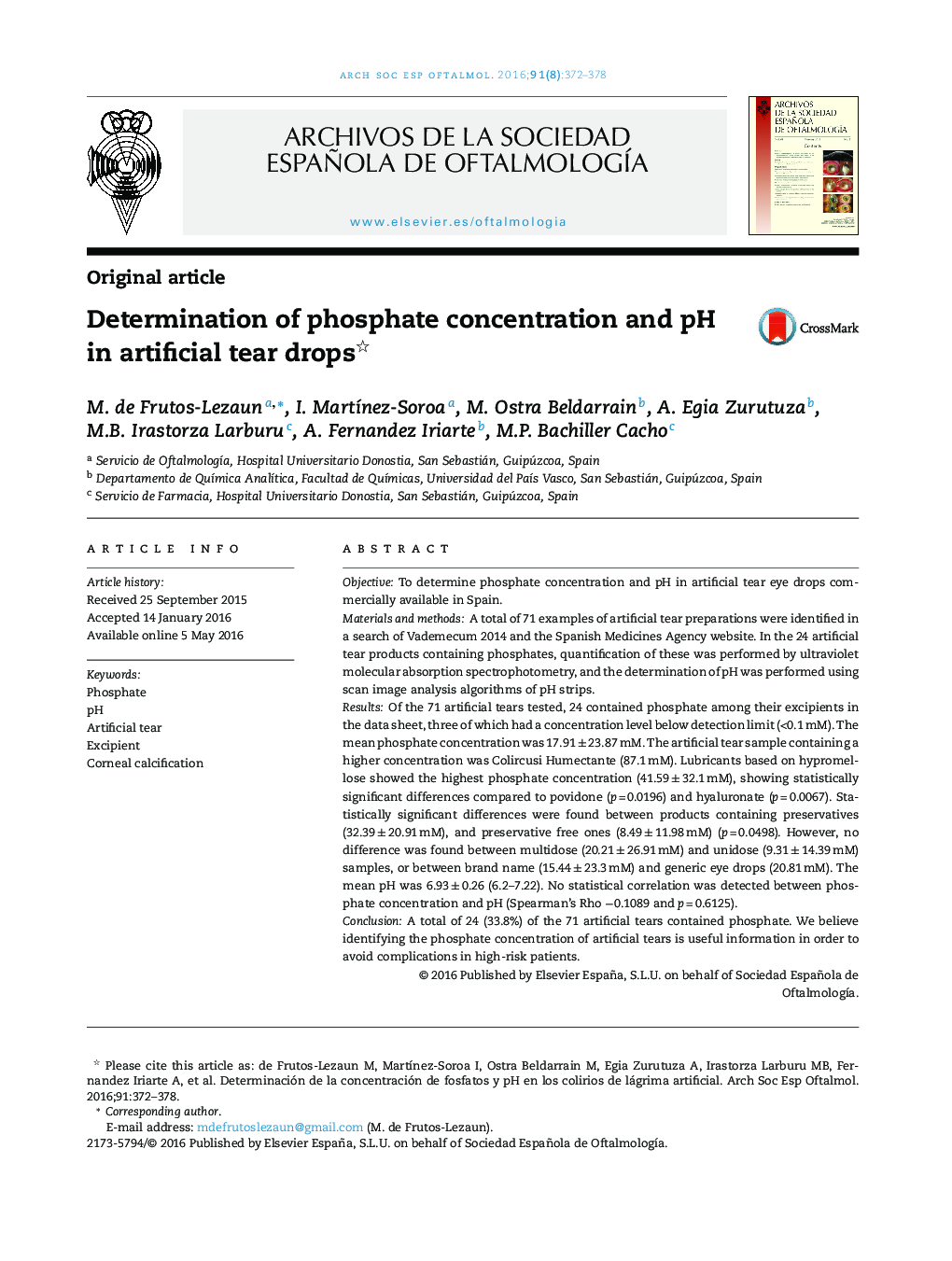| کد مقاله | کد نشریه | سال انتشار | مقاله انگلیسی | نسخه تمام متن |
|---|---|---|---|---|
| 4007934 | 1260836 | 2016 | 7 صفحه PDF | دانلود رایگان |

ObjectiveTo determine phosphate concentration and pH in artificial tear eye drops commercially available in Spain.Materials and methodsA total of 71 examples of artificial tear preparations were identified in a search of Vademecum 2014 and the Spanish Medicines Agency website. In the 24 artificial tear products containing phosphates, quantification of these was performed by ultraviolet molecular absorption spectrophotometry, and the determination of pH was performed using scan image analysis algorithms of pH strips.ResultsOf the 71 artificial tears tested, 24 contained phosphate among their excipients in the data sheet, three of which had a concentration level below detection limit (<0.1 mM). The mean phosphate concentration was 17.91 ± 23.87 mM. The artificial tear sample containing a higher concentration was Colircusi Humectante (87.1 mM). Lubricants based on hypromellose showed the highest phosphate concentration (41.59 ± 32.1 mM), showing statistically significant differences compared to povidone (p = 0.0196) and hyaluronate (p = 0.0067). Statistically significant differences were found between products containing preservatives (32.39 ± 20.91 mM), and preservative free ones (8.49 ± 11.98 mM) (p = 0.0498). However, no difference was found between multidose (20.21 ± 26.91 mM) and unidose (9.31 ± 14.39 mM) samples, or between brand name (15.44 ± 23.3 mM) and generic eye drops (20.81 mM). The mean pH was 6.93 ± 0.26 (6.2–7.22). No statistical correlation was detected between phosphate concentration and pH (Spearman's Rho −0.1089 and p = 0.6125).ConclusionA total of 24 (33.8%) of the 71 artificial tears contained phosphate. We believe identifying the phosphate concentration of artificial tears is useful information in order to avoid complications in high-risk patients.
ResumenObjetivoDeterminar la concentración de fosfatos y el pH de los colirios de lágrima artificial disponibles comercialmente en España.Material y métodosSe identificaron 71 lágrimas artificiales según Vademécum 2014 y página web de la Agencia Española del Medicamento y Productos Sanitarios. En las 24 lágrimas cuya ficha técnica indicaba que contenían fosfatos, se determinó la concentración de estos mediante espectrofotometría de absorción molecular basada en radiación ultravioleta y el pH mediante algoritmos de análisis de imagen por escáner a partir de tiras de papel.ResultadosSe identificaron 71 lágrimas artificiales, de las cuales 24 contenían fosfatos entre sus excipientes; en 3 lágrimas la concentración de estos era menor al umbral de detección (<0,1 mM). La media de la concentración de fosfatos fue 17,91 ± 23,87 mM. La lágrima artificial con mayor concentración fue Colircusi Humectante (87,1 mM). Las que contenían hipromelosa como principio activo presentaban las concentraciones más elevadas (41,59 ± 32,11 mM), observándose diferencias estadísticamente significativas respecto a povidona (p = 0,0196) e hialuronato (p = 0,0067). También se registraron diferencias estadísticamente significativas entre lágrimas con conservantes (32,39 ± 20,91 mM) y sin ellos (8,49 ± 11,98 mM) (p = 0,0498). Sin embargo, no se observaron entre lágrimas con presentación multidosis (20,21 ± 26,91 mM) o monodosis (9,31 ± 14,39 mM) ni entre marcas comerciales (15,44 ± 23,3 mM) y genéricos (20,81 mM). La media del pH hallado fue de 6,93 ± 0,26 (6,2-7,22), sin observar una correlación entre este valor y la concentración de fosfatos (Rho de Spearman: −0,1089 con p = 0,6125).ConclusiónEl 33,8% de las lágrimas contenían fosfatos (24 de 71). Consideramos que conocer la concentración de fosfatos de las lágrimas artificiales es una información útil que nos permitirá evitar complicaciones potencialmente graves en pacientes de riesgo.
Journal: Archivos de la Sociedad Española de Oftalmología (English Edition) - Volume 91, Issue 8, August 2016, Pages 372–378